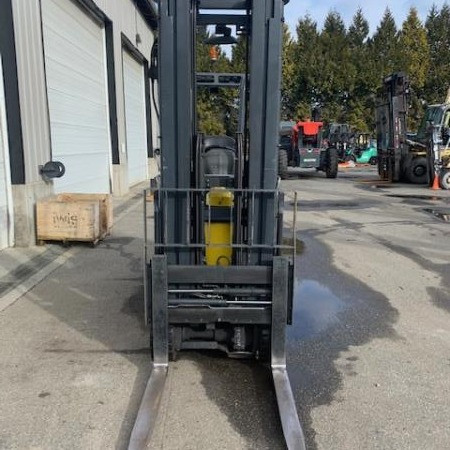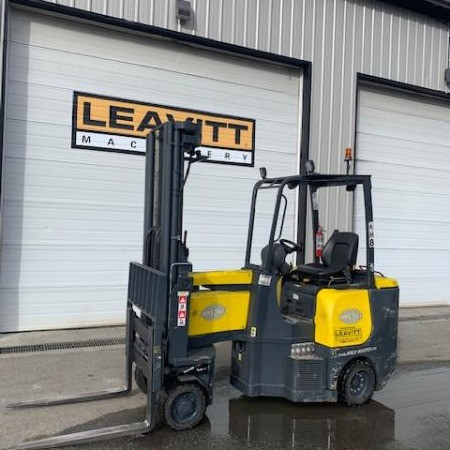Very Narrow Aisle Forklift Norwalk
Used Very Narrow Aisle Forklift Norwalk - Getting items from one warehouse location to another and to and from the loading docks is the focus of warehousing. Focus is often on space saving tools and the layout of the building. Extremely narrow aisles offer more storage space since there is less space needed for aisle access. Configuring the warehouse is known as warehouse optimization.
Warehouse Optimization
Several benefits can be enjoyed for adding very narrow aisle warehouse optimization such as more storage space for the facility.
Because very narrow forklift trucks were developed to take up less space in maneuvering, it is now possible to decrease warehouse aisle width to less than half the width required by standard forklifts. Certain models of very narrow aisle forklifts can increase the square foot storage capabilities by delivering greater stacking heights. Costs can be drastically decreased with a narrow aisle forklift compared to a standard aisle configuration as less warehouse space is required for the same quantity of stock. Most urban locations have expensive square footage; therefore, reducing costs is a benefit to warehouses and their business. When planned carefully and properly, it is possible to increase warehouse storage area by up to 80 percent by implementing a very narrow aisle width configuration. Very narrow aisle design facilitates greater product access and more rack faces. Reduced travel time for storing items and gathering products are some of the key benefits to this warehouse layout as more products are found in an accessible location.
Warehouse layouts usually utilize a narrow aisle or very narrow aisle plan. Less than eleven feet of aisle width is needed by narrow aisles. Very narrow aisles usually use an aisle width of approximately 6.5 feet across. Either of these widths drastically increases storage potential. Using a forklift for order picking and stocking can be difficult in these aisle widths, especially when turning. A variety of very narrow forklifts have been designed to easily maneuver in narrow aisles.
When selecting a forklift for a job application, it is essential to know the aisle dimensions. Taking note of the proper dimensions will save valuable time and money by avoiding the mistake of acquiring a forklift that will not work in the intended application. Taking note of any utilities, columns or posts is necessary before choosing a particular narrow aisle forklift design to maximize warehouse optimization and safety.
Very Narrow Aisle Forklift Trucks
As these units are mostly powered by electricity, rechargeable batteries are popular for very narrow aisle forklifts. These very narrow aisle trucks are more commonly available as stand-up riders, which helps increase productivity and operator comfort. The most commonly used types of very narrow aisle forklift trucks are:
1. Reach trucks
2. Order pickers;
3. End-control riders; and
4. Turret or swing-mast.
Reach Forklift Trucks
Reach trucks were designed as a version of the rider stacker forklift but specially modified for use in narrow aisles. It got its name by its function of reaching its forks forward to get to a load. The two kinds of reach trucks the moving carriage and the moving mast. The moving carriage works by raising and lowering the carriage, along with the operator. While the operator stays at ground level, the moving mast is responsible for raising and lowering the forks. Of the two kinds of reach trucks, the moving mast reach truck is the safer of the two varieties. Reach trucks use a pantograph system, a type of jointed framework, which allows the operator to reach for or place a load without the need to move the forklift itself.
Order Pickers
Order pickers have been created to pick items from difficult, high racking systems. Order pickers are specific for lighter stock items that can be lifted by hand. They lift the operator up to reach the goods by identifying and choosing certain items to create an order.
End-Control Riders
End-control riders are used to pick loads located at floor level and transport the load horizontally, rather than lift or lower loads from various heights.
Turret or Swing-Mast Forklift
Turret or swing-mast very narrow aisle forklift have a pivoting articulating swivel mast. The mast swivels allowing pallets to be placed on either the left or right of the forklift.
Guided Very Narrow Aisle Trucks
Many very narrow aisle forklift trucks are able to be guided down aisles by wire or rail.
Because the forklift is guided, thereby reducing the possibility of the forklift bumping racks while moving down the aisle, the aisles can be extremely narrow. In rail-guided models, sets of rails are placed into the floor on each side of the aisle. They run the length of the aisle and also curve around the aisles’ edge. Specific wheel guides are on the forklift. These slide into the rails to stop the forklift from moving out of the rail guards.
The wire-guidance system requires that the wires be installed into the floor, along the center of the aisle. The wire-guides function similarly to the rail systems except the forklift has a wire-guide system to prevent the machine from traveling where it is not supposed to.
Work Site Considerations
Certain essential considerations need to be dealt with before using a narrow aisle configuration. The floor and the rack construction needs to be evaluated to avoid any issues since the very narrow aisle units have extremely high racking systems. Four specific areas need to be perfectly prepared before a racking system can be implemented including a level floor, plumb racks, any floor cracks need to be repaired and the floor’s load capacity must be accurate. These locations need to be maintained and monitored continuously.
Level Floor
Due to the racking system height, any minor floor slope can gravely impact how plumb the racks are, particularly over time if loads are placed and removed repeatedly on the racks. The height of the racking system means that any minute floor slope can have a negative impact on how straight the racks are, especially over time when loads are continually removed and placed on the racks. Without this foundation of a level floor, the stability of the racks could be jeopardized.
Crack Repair
When there are floor cracks found, they need to be assessed and immediately fixed for safety concerns. Safety can become compromised when flooring cracks become 3/8 inches wide. They require proper filling with a substance that is as hard as the floor.
Floor Load Capacity
The floor needs to meet specific minimum requirements prior to a narrow aisle configuration. At a minimum, the floor should consist of 3,000 psi concrete as well as contain evenly distributed rebar approximately 3 to 4 inches below the surface. Depending on the load requirements and configuration, additional reinforcements may be needed.
Plumb Racks
Of great importance is the proper installation of the racking system. If installed improperly, there is a great chance of rack failure. One of the most important details to ensure proper installation, is that all racks are plumb. If necessary, rack shims should be used to ensure the racks are plumb within 1 inch at the 30 foot height of the racks.
If the above measures are not taken or are improperly implemented, it is likely to cause a racking failure. Racking failure can kill or injure employees, damage equipment and result in horrible damage. Because of these reason, these measures are the most important part of implementing a narrow aisle configuration for warehousing optimization.
Very Narrow Aisle Forklift PDF
Stock Number: 207213 GL
Make: AISLEMASTER
Model: 44E
Year: 2013
| Stock Number |
207213 GL |
| Make |
AISLEMASTER |
| Model |
44E |
| Year |
2013 |
| Category |
Very Narrow Aisle Forklift |
Stock Number: 208758 GL
Make: AISLEMASTER
Model: 44SE
Year: 2015
| Stock Number |
208758 GL |
| Make |
AISLEMASTER |
| Model |
44SE |
| Year |
2015 |
| Category |
Very Narrow Aisle Forklift |
Stock Number: 209213 GL
Make: AISLEMASTER
Model: 44SE
Year: 2015
| Stock Number |
209213 GL |
| Make |
AISLEMASTER |
| Model |
44SE |
| Year |
2015 |
| Category |
Very Narrow Aisle Forklift |













